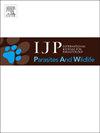Cuckoo eyes are an important identification cue for the Oriental reed warbler host
IF 2
3区 医学
Q3 ECOLOGY
International Journal for Parasitology-Parasites and Wildlife
Pub Date : 2025-01-10
DOI:10.1016/j.ijppaw.2025.101038
引用次数: 0
Abstract
Successful recognition of parasites through effective identification cues can reduce the cost of anti-parasitic defenses by the host. Features on the front of the body such as the eyes may be important clues for the prey to perceive and recognize the parasite. In this study, we investigated whether the eyes of common cuckoos (Cuculus canorus), an obligate avian brood parasite, served as identification cues for its common host, the Oriental reed warbler (Acrocephalus orientalis). We displayed dummies of 3D printed common cuckoos and Oriental turtle doves (Streptopelia orientalis) with their eyes covered or not-covered near the nests of breeding Oriental reed warblers to test effect of the eyes on defense behaviors of the warblers towards these dummies. Oriental reed warblers significantly reduced attacks on the common cuckoos with eyes covered compared to those with eyes not-covered. However, there was no significant difference between the attacks on the Oriental turtle doves with not-covered eyes and those with covered eyes. Our results suggest that Oriental reed warblers use cuckoo eyes as an important discrimination cue. We explored for the first time the use of the cuckoo's eye as an important discriminative cue by Oriental reed warblers via visual manipulation of 3D printed cuckoos, which provides a new experimental validation of the host Oriental reed warbler's anti-parasite strategy in terms of visual cues. However, Future research should consider testing more cuckoo species and their hosts and further validating the identification cues of the eyes and other body parts in additional geographic populations.

杜鹃的眼睛是东方苇莺宿主的重要识别线索。
通过有效的识别线索成功识别寄生虫可以降低宿主抗寄生虫防御的成本。身体前部的特征,如眼睛,可能是猎物感知和识别寄生虫的重要线索。在本研究中,我们研究了普通杜鹃(Cuculus canorus)的眼睛是否能作为其共同寄主东方芦莺(Acrocephalus orientalis)的识别线索。我们在繁殖的东方芦苇莺的巢附近展示了3D打印的普通杜鹃和东方斑鸠(Streptopelia orientalis)的假人,它们的眼睛被覆盖或不被覆盖,以测试眼睛对莺对这些假人的防御行为的影响。东方芦苇莺对蒙住眼睛的杜鹃的攻击比没有蒙住眼睛的杜鹃明显减少。而对不蒙眼斑鸠和蒙眼斑鸠的攻击没有显著差异。结果表明,东方苇莺以杜鹃的眼睛作为重要的识别线索。通过3D打印布谷鸟的视觉操纵,首次探索了杜鹃眼作为东方苇莺重要的判别线索,为宿主东方苇莺在视觉线索方面的抗寄生虫策略提供了新的实验验证。然而,未来的研究应该考虑在更多的地理种群中测试更多的杜鹃物种及其宿主,并进一步验证眼睛和其他身体部位的识别线索。
本文章由计算机程序翻译,如有差异,请以英文原文为准。
求助全文
约1分钟内获得全文
求助全文
来源期刊

International Journal for Parasitology-Parasites and Wildlife
Medicine-Infectious Diseases
CiteScore
3.80
自引率
5.60%
发文量
113
审稿时长
45 days
期刊介绍:
The International Journal for Parasitology: Parasites and Wildlife (IJP-PAW) publishes the results of original research on parasites of all wildlife, invertebrate and vertebrate. This includes free-ranging, wild populations, as well as captive wildlife, semi-domesticated species (e.g. reindeer) and farmed populations of recently domesticated or wild-captured species (e.g. cultured fishes). Articles on all aspects of wildlife parasitology are welcomed including taxonomy, biodiversity and distribution, ecology and epidemiology, population biology and host-parasite relationships. The impact of parasites on the health and conservation of wildlife is seen as an important area covered by the journal especially the potential role of environmental factors, for example climate. Also important to the journal is ''one health'' and the nature of interactions between wildlife, people and domestic animals, including disease emergence and zoonoses.
 求助内容:
求助内容: 应助结果提醒方式:
应助结果提醒方式:


